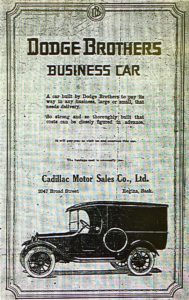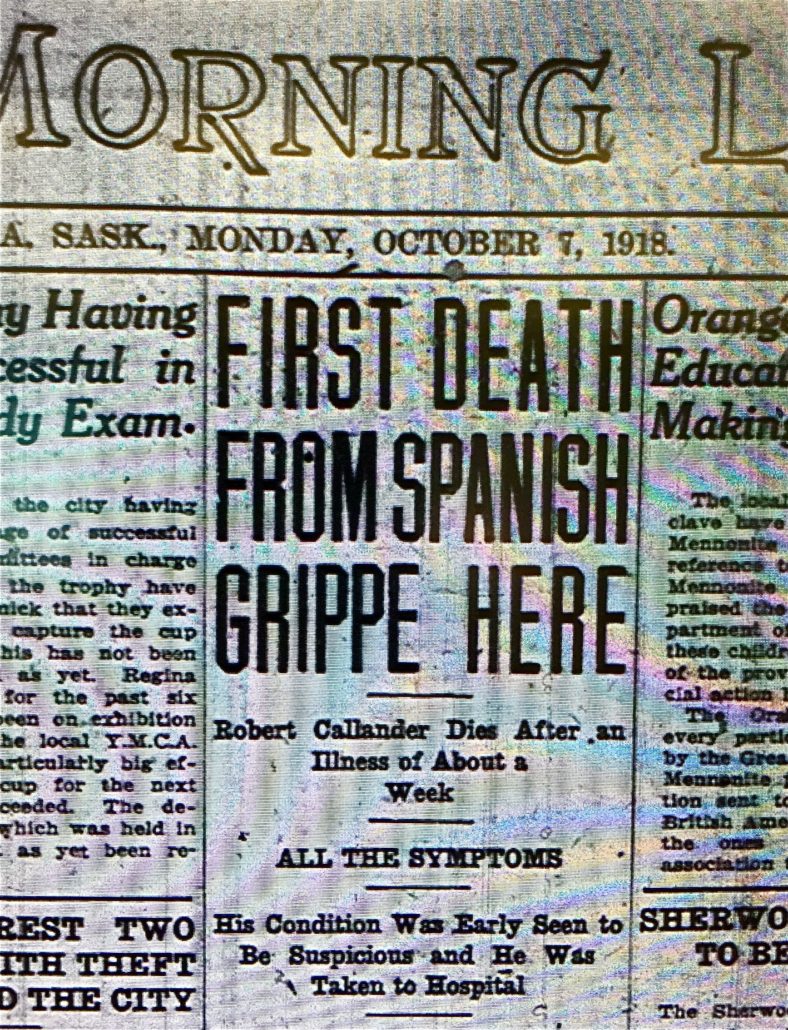When automobiles were used to fight the Spanish flu in 1918
This article was originally published by the Regina Leader-Post on March 20, 2020. It is reprinted here with permission.
By Dale Edward Johnson
At first, people in Saskatchewan showed little interest or concern about reports of a new flu in other parts of the world.
The first cases were reported in Canada in July 1918, and it would be a few more months before cases were reported in Saskatchewan. As health authorities scrambled to try to reduce the number of people stricken, owners of automobiles in Regina were asked to help out. And they did.
As the summer of 1918 turned to autumn, there were more newspaper reports of the Spanish flu in cities in the eastern U.S. and Canada.
For example, on Oct.1, 1918, Regina’s Morning Leader newspaper reported there were 460 new cases in Philadelphia in the previous 48 hours, bringing the city’s total to 2,327 cases and 14 deaths.
By Oct. 3, the Leader reported that the Spanish flu was “rapidly spreading over (the) United States” and was in 43 of the 48 states.
In Canada, there were 150 cases of the flu at military barracks in Montreal, and one death, and the Leader said, “It is necessary to take every possible precaution to prevent the spread of the disease…The best means of preventing the spread of this disease is early isolation of the patient who should wear a gauze mask.”
The flu got little media coverage, as most newspaper articles focused on how the Great War was in its final stages.
On Oct. 5, the Leader reported six deaths in Montreal, five in Quebec City and four in Sherbrooke, Quebec. In response, Sherbrooke ordered all theatres closed and all public meeting suspended.
The first death in Saskatchewan was front-page news in Regina on Oct. 7, 1918. when Robert Callander died in Regina General Hospital after being ill for a week.
“Every precaution has been taken with this case to prevent a spread of the disease,” the Leader reported.
“There is no question we are liable to have some trouble with Spanish influenza.”
Regina’s medical health officer, Dr. Bow, said, “There is no question we are liable to have some trouble with Spanish influenza. The disease appears to be sweeping through the country and we cannot expect to be immune.”
But Regina residents had other things on their minds, like organizing a victory parade, or attending an evangelical rally that evening. About 2,000 people jammed the Auditorium Rink, at Rose St. and 12th Ave.
The Spanish flu soon spread very quickly in Regina.
Just two days later – on Oct. 9, 1918 – in a front-page article, the Leader said the Spanish flu “is spreading rapidly throughout Saskatchewan and a large number of cases have been reported to Dr. Seymour, the provincial health commissioner, who has taken steps to restrict the disease as far as possible.”
A second death was reported, and people in several communities were showing symptoms, including a severe headache, fever, dry cough and sore throat. The province asked people with symptoms to stay isolated in their homes. But some were taken to hospital. Soon some of the doctors and nurses also came down with the flu. And, 12 people were turned away because the Grey Nuns Hospital (now the Pasqua Hospital) had no more room.
Public schools had already been closed in several other cities in North America, but Seymour said, “The desirability of closing schools in a city or town in the presence of an epidemic is a measure of doubtful value.”
On Oct. 12, there was another death and another 15 new cases in Regina.
In New Brunswick, where the situation was more serious, there was a ban on public gatherings, and theatres, churches and schools were ordered closed. Saskatchewan government officials said there were no plans to do the same thing here, unless things got “considerably worse.”
Indeed, things did soon get worse – and the automobile would be called in to help fight the flu in Regina.
The automobile had proven its value during the First World War, showing it was a more efficient way than horses to move soldiers and munitions to the battlefields across Europe. Motorized ambulances also proved far preferable to horse-drawn ambulances.
Automobiles were becoming more commonplace in Regina
Before the war started in 1914, there were plenty of skeptics about automobiles, which were largely considered a plaything of the rich. But those societal attitudes changed immensely during the Great War, when the practical applications of motorized vehicles were clearly demonstrated.
Businesses saw the value of replacing horses with cars, and automobiles were becoming more commonplace in Regina in the late teens.

Dodge Brothers automobiles were sold at Regina’s Cadillac dealership. This ad promises that the Business Car will “pay its way in any business.”
There were plenty of dealerships in the city, including the Cadillac Motor Sales at 2047 Broad St., Canadian Motor Sales at 1960 Albert St., Great West Motors at 1749 Cornwall St., the Ryan Garage at 1866 Hamilton St., the Saskatchewan Motor Co, the Ford dealership, at 1951 Rose St., and Willys-Overland at Twelfth Ave. and Hamilton St.
Regina was a growing, prosperous community, and with the end of the war in sight, people were starting to prepare for peacetime.
Each day in October, the flu grabbed more headlines. All areas of Saskatchewan were reporting people had the flu.
On Oct. 15, a 21-year-old teacher, Aurilla Kerr, died of the flu. Her brother and mother had also died from the flu a few days earlier.
There were 15 new cases that day, and the provincial health commissioner repeated his advice to avoid crowds and wear a face mask. Dr. Seymour also said, “I do not think it is a good plan to close schools. Neither do I think it necessary to close churches.”
By Oct. 16 – just one week after the first death was reported in Regina – 11 people had died and there were 150 cases in all.
Nurses were working overtime, and some caught the flu.
On Oct. 17, the Leader reported that public places were people gathered, including theatres and churches, were being shut down – although schools remained open. There were 60 new cases reported the previous day – double the number reported the day before.
The Separate school board held a special meeting and decided to close its three schools in Regina.
With overcrowding at the two hospitals in the city, the Separate school board offered St. Joseph School as a temporary facility to help handle the overflow from the city’s two hospitals. Some teachers volunteered to help nurses. In all, 3,000 people would be treated at St. Joseph School.
Meanwhile, many of the teachers in the public school system caught the flu and had to stay home. As well, many of the students were kept at home by their parents. About 75 per cent of students were absent. Less than a week later, the public school system also shut down. Teachers were urged to volunteer at hospitals, and most of the 65 did.
The Regina Public Library was one public institution that did not close down.
“One of the principal reasons for keeping the library open is the providing of an antidote in the form of healthy and entertaining literature,” the Leader said.
By Oct. 21, there were 450 cases in Regina and 31 people had died from the flu.
“The forty citizens who arrived with their cars did excellent work.”
On Oct. 25, the city asked automobile owners to lend their vehicles and time to help in the battle against the flu. And car owners responded – about 40 in all.
At first, they drove overworked doctors and nurses from their homes to hospitals.
Later, they were asked to help do a door-to-door survey of the city to see precisely how widespread the flu was in Regina.
“The forty citizens who arrived with their cars did excellent work and as a result of their efforts by nightfall one-half of the districts into which the city had been divided had been canvassed,” the Leader said.
Those flu-fighting volunteers came from a variety of fields.
Some of them were prominent citizens, including:
- David Bennett, the western sales manager for the Oshawa-based Chevrolet Motor Company
- Dr. Howard Cawsey, an inspector with the Health of Animals Branch with the Dominion Department of Agriculture
- George S. Kennedy, a lawyer
- Dr. Herbert McClung, an optometrist
- John Snow, manager of the Regina branch of the Dominion Bank
- Thomas Young, proprietor of the Rose Theatre
As well, some traveling salesmen volunteered to help. Their business had dropped off when the flu hit, and they suddenly had lots of free time. Among
them:
- Walter Bright, a salesman for Wilson Stationary
- Thomas Dawkins, a salesman for the Lloyd Fruit company
- Thomas Jacklin, a salesman for a wholesale grocer
- And, others who owned automobiles also volunteered, including:
- Rev. Hugh Leitch, the paster at Westminster Presbyterian Church
- John McCarthy, the manager of the Paris Hotel at 1623 Broad St.
- Glassford Muir, a Presbyterian minister and journalist
The survey by these people showed there were about 2,000 cases of the flu in Regina.
By the end of October, 134 people had died in Regina from the flu.
On November 11, the First World War officially came to an end. About 8,000 people gathered at Wascana Park to celebrate.
But the Spanish flu continued.
By the end of December 1918, a total of 3,906 people had died from the flu in Saskatchewan. In 1919 another 1,101 people would die from the flu and in 1920 another 102 died, bringing the provincial total to 5,018 people, including 330 deaths in Regina.




Leave a Reply
Want to join the discussion?Feel free to contribute!